| Linares (2009) |
|
The 26th Torneo Intercontinental de Ajedrez Ciudad de Linares was again staged only in Spain. In the previous three years, the first half of the tournament was in Morelia, Mexico (hence the "Intercontinental"). It was rumored that next year the first half would probably be in the Arab Emirates. The participants were: World Champion Viswanathan Anand (Elo ranked #2 in the world), Vassily Ivanchuk (#3), Magnus Carlsen (#4), Teimour Radjabov (#6), Levon Aronian (#11), Wang Yue (#13), Alexander Grischuk (#14), and Leinier Dominguez Perez (#23). Grischuk replaced Veselin Topalov (#1) who had to withdraw because of a new schedule for the Topalov - Kamsky Candidates Final (2009). Games started at 4 pm in Teatro Cervantes. Grischuk won on tiebreak (more wins) ahead of Ivanchuk. Linares, Spain, 19 February - 7 March 2009 Age Elo 01 02 03 04 05 06 07 08
1 Grischuk 25 2733 ** ½½ ½0 ½½ 1½ 1½ 1½ ½½ 8
2 Ivanchuk 39 2779 ½½ ** ½½ ½½ ½½ ½½ 11 ½½ 8
3 Carlsen 18 2776 ½1 ½½ ** 1½ ½½ ½0 ½0 ½1 7½
4 Anand 39 2791 ½½ ½½ 0½ ** 1½ 1½ 0½ ½½ 7
5 Radjabov 21 2761 0½ ½½ ½½ 0½ ** ½½ ½1 ½½ 6½
6 Wang Yue 21 2739 0½ ½½ ½1 0½ ½½ ** ½½ ½½ 6½
7 Aronian 26 2750 0½ 00 ½1 1½ ½0 ½½ ** 1½ 6½
8 Domínguez 25 2717 ½½ ½½ ½0 ½½ ½½ ½½ 0½ ** 6
Category: XXI (2756). Arbiters: Juan Vargas and Faik Gasanov.Video Round 10: https://www.youtube.com/watch?v=f0D... Video Round 14: https://www.youtube.com/watch?v=izy... Sources
ChessBase, 3/7/2009 (https://en.chessbase.com/post/linar...)
ChessBase, 2/19/2009 (https://en.chessbase.com/post/linar...)
FIDE rating list January 2009 (http://fidelists.blogspot.com/2009/...)
Mark Crowther in TWIC 748 (http://theweekinchess.com/html/twic...)
Spanish ChessBase, 19/02/2009 (https://es.chessbase.com/post/la-in...)
Daaim Shabazz in The Chess Drum, 20 Feb - 7 March 2009 (http://www.thechessdrum.net/blog/20...)
Ian Rogers in Peón de Rey, No. 80 (May-June 2009), pp. 8-18 (https://e-nautia.com/santiago/disk/...) Round dates: February 19, 20, 21, 22, 24, 25, 26, 28, March 1, 2, 3, 5, 6, 7 (from TWIC and ChessBase). Previous: Morelia-Linares (2008). Next (and last): Linares (2010)
|
|
| page 1 of 3; games 1-25 of 56 |
     |
 |
| Game |
| Result | Moves |
Year | Event/Locale | Opening |
| 1. Aronian vs Carlsen |
 | ½-½ | 37 | 2009 | Linares | E06 Catalan, Closed, 5.Nf3 |
| 2. L Dominguez Perez vs Grischuk |
 | ½-½ | 30 | 2009 | Linares | C18 French, Winawer |
| 3. Y Wang vs Ivanchuk |
 | ½-½ | 31 | 2009 | Linares | E11 Bogo-Indian Defense |
| 4. Anand vs Radjabov |
  | 1-0 | 61 | 2009 | Linares | B33 Sicilian |
| 5. Anand vs Aronian |
  | 0-1 | 53 | 2009 | Linares | D47 Queen's Gambit Declined Semi-Slav |
| 6. Carlsen vs L Dominguez Perez |
 | ½-½ | 18 | 2009 | Linares | A33 English, Symmetrical |
| 7. Radjabov vs Ivanchuk |
 | ½-½ | 42 | 2009 | Linares | E94 King's Indian, Orthodox |
| 8. Grischuk vs Y Wang |
 | 1-0 | 57 | 2009 | Linares | D17 Queen's Gambit Declined Slav |
| 9. Aronian vs Radjabov |
 | ½-½ | 42 | 2009 | Linares | E61 King's Indian |
| 10. L Dominguez Perez vs Anand |
 | ½-½ | 42 | 2009 | Linares | B90 Sicilian, Najdorf |
| 11. Y Wang vs Carlsen |
 | ½-½ | 57 | 2009 | Linares | D37 Queen's Gambit Declined |
| 12. Ivanchuk vs Grischuk |
 | ½-½ | 65 | 2009 | Linares | E20 Nimzo-Indian |
| 13. Aronian vs L Dominguez Perez |
 | 1-0 | 92 | 2009 | Linares | D27 Queen's Gambit Accepted, Classical |
| 14. Radjabov vs Grischuk |
 | 0-1 | 41 | 2009 | Linares | E17 Queen's Indian |
| 15. Carlsen vs Ivanchuk |
 | ½-½ | 34 | 2009 | Linares | D81 Grunfeld, Russian Variation |
| 16. Anand vs Y Wang |
  | 1-0 | 33 | 2009 | Linares | D15 Queen's Gambit Declined Slav |
| 17. L Dominguez Perez vs Radjabov |
 | ½-½ | 62 | 2009 | Linares | B77 Sicilian, Dragon, Yugoslav Attack |
| 18. Y Wang vs Aronian |
 | ½-½ | 26 | 2009 | Linares | D12 Queen's Gambit Declined Slav |
| 19. Ivanchuk vs Anand |
  | ½-½ | 65 | 2009 | Linares | D19 Queen's Gambit Declined Slav, Dutch |
| 20. Grischuk vs Carlsen |
 | ½-½ | 34 | 2009 | Linares | B33 Sicilian |
| 21. Y Wang vs Radjabov |
| ½-½ | 43 | 2009 | Linares | E92 King's Indian |
| 22. Ivanchuk vs L Dominguez Perez |
 | ½-½ | 47 | 2009 | Linares | A04 Reti Opening |
| 23. Grischuk vs Aronian |
 | 1-0 | 59 | 2009 | Linares | D44 Queen's Gambit Declined Semi-Slav |
| 24. Carlsen vs Anand |
  | 1-0 | 77 | 2009 | Linares | D45 Queen's Gambit Declined Semi-Slav |
| 25. L Dominguez Perez vs Y Wang |
 | ½-½ | 57 | 2009 | Linares | C42 Petrov Defense |
 |
| page 1 of 3; games 1-25 of 56 |
     |
|


|
|
< Earlier Kibitzing · PAGE 189 OF 192 ·
Later Kibitzing> |
| Mar-12-09 | | hrvyklly: This is Smyslov: "His harmonious positional understanding and deep intuition would have made Morphy a highly dangerous opponent even for any player of our times." Sorry to be quoting all the time, but let's face it, when Smyslov (of all people) says that, then I've got to quote him! And here's Alekhine on Morphy: "... deeply considered positional play, primarily of an aggressive character." |
|
| Mar-12-09 | | KingG: By the way, in his Chess Puzzle Book, John Nunn did some computer analysis of the games from Karlsbad 1911 to see how they compared with today's games, and he was far from impressed. It's far too long to reproduce here, so I'll just link to John Watson's review of the book where he quotes a large portion of that section: http://www.chesscenter.com/twic/jwa... I really recommend you all to read it, it's fascinating. Here are the missing diagrams and examples from Watson's review. I only give a few lines of Nunn's comments, there are more in his book: H Suechting vs Alekhine, 1911
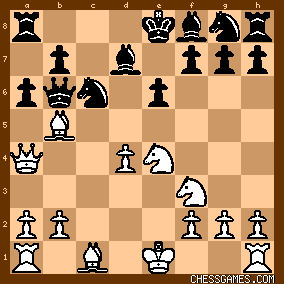
click for larger view10.0-0??
Teichmann vs H Suechting, 1911
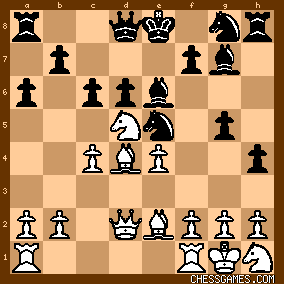
click for larger view18...c6??
E Cohn vs H Suechting, 1911
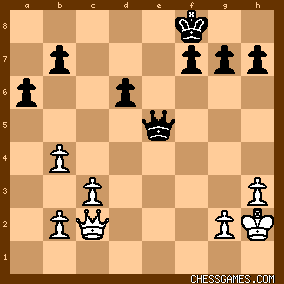
click for larger view<Position agreed drawn when White Black could have hoped for more.> Tartakower vs Leonhardt, 1911
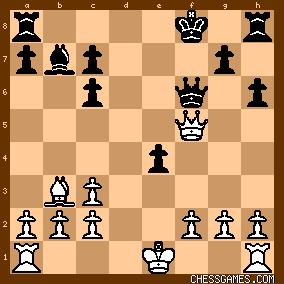
click for larger view20.Qxf6??
<Just incomprehensible. This blunder is far worse than a simple tactical oversight. White, at one stroke, removes the advantage conferred by Black's poor king position, and improves Black's pawn structure.> P F Johner vs Tartakower, 1911
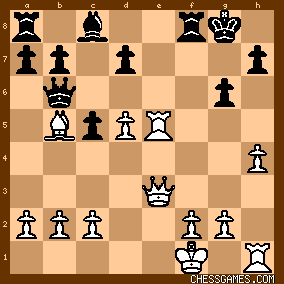
click for larger view17.Be2? <A poor move which allows Black not only to take the b-pawn, but to do so with gain of tempo, as White has to spend time dealing with the danger on the back rank.> Fahrni vs Burn, 1911
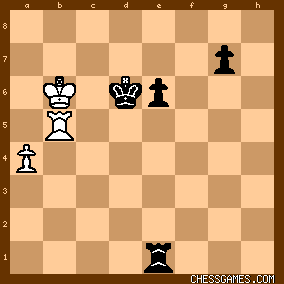
click for larger view
It may seem extraordinary that Black, to move, lost this ending with an extra pawn. In fact, Black could draw quite comfortqbly even if both his pawns were removed from the board!
<...>
64...g4?? <An extraordinary blunder, allowing White to gain a queen!> C Jaffe vs O Chajes, 1911
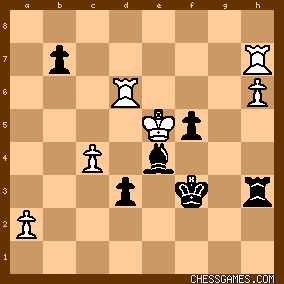
click for larger view
56.Rxb7?? <A total miscombination. After 56.Rhd7 White would have had chances of victory, although to be fair the position would not be easy to win.> 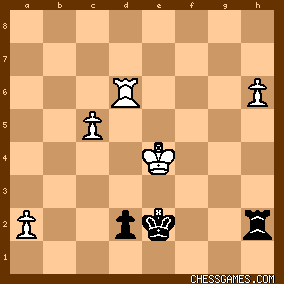
click for larger view62.c6?? <A truly horrible move after which White is even in danger of losing.> 75.Rd8? <A serious error, after which Black can penetrate into White's fortress.> <...> 83.Ka8 Kc7 0-1 <To lose an ending with a clear extra exchange and pawn is remarkable.> |
|
| Mar-12-09 | | Jim Bartle: As I understand it, the supposed advantage today's players have is in deeper knowledge of openings. So why not discuss whether Morphy or any other player of the past is the equal of today's players starting from a middle game position which is considered about equal? In other words, look at the quality of Morphy's (or Capablanca's) play after, say, move 20 against strong opposition and see how it holds up, and skip analysis of the openings. |
|
Mar-12-09
 | | keypusher: <'Morphy proved himself clearly superior to each opponent. All four of them showed in single games that they could play very strongly; each of them managed to really outplay Morphy in at least one game. Morphy was clearly better on the whole in the opening and he mostly converted his winning positions. But I cannot recognize that he knew more about chess than his opponents (with the exception of the opening) nor that he already had mastered positional precepts, as defined later by Steinitz. Perhaps Morphy's rapid rate of play (according to eye-witnesses) also contributed to the fact that his contemporaries and even opponents admired him beyond all measure. Also the fact that the 20 year-old Morphy was extraordinarily young for a chessplayer at that time may have led to the idolization of the American which took place. Morphy also made mistakes but there was no area of the game which influenced playing strength in which he was inferior to an opponent.' Knaak goes on to characterize Morphy as greatly superior in the opening; he was also good in the middlegame, but in the latter case only on about the same level or slightly better than his worthy opponents. In this context we see Knaak's controversial stand that Morphy's understanding of positional chess was nothing special even for his day; he also emphasizes Morphy's mistakes in closed positions. According to Knaak, Morphy played the ending well but was not markedly superior to his opponents. As indicated above, he emphasizes that Morphy was not inferior to his opponents in any of these phases. But he also thinks that the ecstatic praise of his genius is a bit much. Knaak illustrates his thesis with some well-annotated games and a selection of mistakes by Morphy against each opponent. I like this CD and think that its new take on Morphy is probably more accurate than previous ones. At the very least we have a serious and well thought out contribution to historical analysis by a first-rate analyst.> Knaak, from another Watson review. Thanks for finding the Carlsbad review, KingG, I always wanted to read that. http://www.chesscenter.com/twic/jwa...
<Jim Bartle> It's been done. Morphy scores very well for a 19th century master, poorly for a 20th century GM. Of course, as AlexM pointed out, he wasn't really pushed, and had a 2-year career, so who knows? But going on what he did rather than what he might have done, claims that he could have beaten any modern player seem silly to me. |
|
Mar-12-09
 | | alexmagnus: That quote from Nunn may be shocking for the fans of old masters: <The first was a tendency to make serious oversights. It is quite clear that the Karlsbad players were far more prone to severe errors than contemporary players. Even the leading players made fairly frequent blunders. Rubinstein, for example, who was then at virtually the peak of his career (1912 was his best year) failed to win with a clear extra rook against Tartakower ... He also allowed a knight fork of king and rook in an ending against Kostic... The second problem area was an inclination to adopt totally the wrong plan...[examples follow]... The third main problem area was that of endgame play...[horrendous examples of elementary blown endgames follow]... ... Remember that all the examples given here were played in one tournament...> |
|
| Mar-12-09 | | hrvyklly: <alexmagnus> Yeah, but Nunn never produced anything as good as this. Rotlewi vs Rubinstein, 1907 I look forward to 100 years from now and someone dismissing his talent in such terms ;-) |
|
| Mar-12-09 | | Jim Bartle: No argument with you overall, hrvyklly, but I must say this game holds up pretty well with Rotlewi vs Rubinstein: Beliavsky vs Nunn, 1985 |
|
| Mar-12-09 | | hrvyklly: Well, yeah, I started to think of good Nunn games after I wrote what I did - I just dislike Nunn to be honest. |
|
| Mar-12-09 | | amadeus: <You can put Morphy's moves through a computer and see how he stacks up against modern GMs. Not very well.> Greetings. I took the time to visit truechess site -- http://www.truechess.com/web/champs... --, and I have compared Morphy's blunder-rate and "better than average move" mean* to the rate of all world champions when they were of the same age (20-22 years old). Well, it seems that Morphy is on the same level as them. Even without 50, 100, 150 years of theory**. Not bad for an amateur from the middle 1800s, who played faster than his opponents and drank a bit too much wine at night :) (*) if I am not mistaken, something similar to error average - (7+4*complexity/30)/ (7+4*complexity/30) [sorry if I am wrong] (**) Steinitz is not listed, but he was much worse even a couple of years later (his early 30s). If I exclude the first champions (Steinitz to Euwe), the result still holds true (but he'll be a bit worse than the average -- less than half a standard deviation though) Were it not by Morphy's match against Mongredien (which he won easily, 7-0, 1 draw, only 1 game above 30 moves, but according to the engine analysis was not very good), things would be even better... Of course, this is not conclusive: engines are far from perfect, the endgame was not analyzed, there are not enough games, e4, d4 and so on. But I think it shows that Morphy was more than just an ugly face. |
|
Mar-12-09
 | | alexmagnus: Truechess analysis has been criticized here thousand times. Reason: the blunder rate of the player depends not only on the player himself but also on his opposition. |
|
Mar-12-09
 | | keypusher: <Amadeus>
Nice cherry-picking. Overall Truechess rates Morphy 15th measured by best one year, two year or three year period. http://www.truechess.com/web/champs...
He can't be measured over longer periods, obviously. Why does Morphy rate so poorly? Well, his blunder rate is fairly high, and his percentage score is not outstanding. But where he really falls short is in the percentage of moves that are better than average GM moves. He has a negative figure in several of the charts. |
|
| Mar-12-09 | | acirce: In <KingG>'s link, John Watson adds some valuable common sense to these ever ongoing discussions, beyond the comparisons themselves. For example: <I'm always hearing (and reading) that "If the players of yesteryear could only catch up with opening theory, they'd be as good or better than today's players". The funny thing is that the many years (usually decades) of study that modern players put into opening theory should not only count towards their strength, but that study and practice contributes vastly to their understanding of the middlegame and even some endgames. The silly idea that you can just 'catch up' in opening theory ignores the vast undertaking that this would involve, especially to absorb the vast number of openings and opening variations necessary to a complete chess education.> |
|
| Mar-12-09 | | acirce: <That quote from Nunn may be shocking for the fans of old masters: <The first was a tendency to make serious oversights. It is quite clear that the Karlsbad players were far more prone to severe errors than contemporary players. Even the leading players made fairly frequent blunders. Rubinstein, for example, who was then at virtually the peak of his career (1912 was his best year) failed to win with a clear extra rook against Tartakower ... He also allowed a knight fork of king and rook in an ending against Kostic...The second problem area was an inclination to adopt totally the wrong plan...[examples follow]... The third main problem area was that of endgame play...[horrendous examples of elementary blown endgames follow]... ... Remember that all the examples given here were played in one tournament...> > Yeah, and here is Watson's comment to this: <In the course of research for a book, I made a lengthy look at endgames from a comparable period and found similar butchery, including some terrible blunders by top players such Lasker. The endgame skills of the great masters - excepting Rubinstein - are much exaggerated in books, for the reasons that Nunn gives, i.e, the understandable selection of a very small set of games for reasons of instruction and beauty.> I think this point is important in general as well, not just for endgames. We remember the old greats for their best games, not their average games. But today we follow and evaluate <all> the games of today's greats with the utmost engine-assisted scrutiny, and as a result, we easily end up making invalid comparisons. |
|
| Mar-12-09 | | Jim Bartle: To quote..myself from March 11 on the Fischer page, similar point to acirce but referring to players from a different era: "Also, there may be an illusion at play here. We tend to see the best games from the 60s and 70s, as others fade from memory. So naturally what we are going to see looks great. Today there are great games and mediocre games and poor games, and we see all of them. "It may be as in pop music. We always say it was so great in the 60s or 70s (OK, not "we," but lots of people) while there's so much dreck today. That's largely because we usually hear only the best from that age, while exposed to everything today. "I've been listening to some oldies stations on itunes, and believe me, there was plenty of really poor music back then. It wasn't all Beatles and Four Tops and Buffalo Springfield." |
|
Mar-12-09
 | | keypusher: <In the course of research for a book, I made a lengthy look at endgames from a comparable period and found similar butchery, including some terrible blunders by top players such Lasker. > I am grieved to read this, of course. I can think of two endgame doozies by Lasker, both from Hastings: he misses the win of a rook against Mason, and responds to a losing blunder by Tarrasch with a losing blunder of his own. J Mason vs Lasker, 1895
Tarrasch vs Lasker, 1895
He makes a number of mistakes against Bogoljubov in this ending. Lasker vs Bogoljubov, 1924
But it was my general impression that he played endgames strongly and accurately. Certainly that seemed to be the case when I looked at the games from the 1908 championship. |
|
| Mar-12-09 | | hrvyklly: <acirce> Yikes! Hadn't thought of Watson's point. |
|
Mar-12-09
 | | keypusher: Meant to ask KingG--what examples of Lasker endgame blunders does Nunn give? |
|
| Mar-12-09 | | whatthefat: <frogbert: <i went to check the Chessmetrics site> the chessmetrics data are in general faulty (and then it doesn't help if the method is better). using the fide historical data is what i generally would recommend, slomarko.> What do you mean by "faulty"? I ask because I have my own questions about the method used by chessmetrics to remove inflation, which I have sent to Sonas but received no reply on the matter (which is particularly odd given he'd replied to other questions in the past). |
|
| Mar-12-09 | | whatthefat: <Jim Bartle: As I understand it, the supposed advantage today's players have is in deeper knowledge of openings. So why not discuss whether Morphy or any other player of the past is the equal of today's players starting from a middle game position which is considered about equal? In other words, look at the quality of Morphy's (or Capablanca's) play after, say, move 20 against strong opposition and see how it holds up, and skip analysis of the openings.> I did such an analysis of Lasker, Capablanca, Tal, and Fischer a while ago and was amazed to find little difference in the level of play between them. Similar, more rigorous, methods have come to similar conclusions - see User: nimh and http://www.chessbase.com/newsdetail... If you start to go further back than Lasker, play starts to drop markedly in quality, especially in the opening. I'm not aware of Morphy's play having been tested like this though. One problem would be the small number of serious events he played in; another is the difficulty involved in factoring in the opposition strength. Nonetheless, I'd be interested to see what kind of results it would turn up. |
|
| Mar-12-09 | | Jim Bartle: Thank you, wtfat. |
|
| Mar-12-09 | | visayanbraindoctor: <whatthefat: I did such an analysis of Lasker, Capablanca, Tal, and Fischer a while ago and was amazed to find little difference in the level of play between them. Similar, more rigorous, methods have come to similar conclusions> That's interesting. I have done no analysis; and it must have taken you quite an effort; so congrats! Even without a computer analysis, I have always been of the impression that Lasker (although he naturally occasionally blundered like all GMs do) generally played at a very high level, higher than those who came before him. Higher than even the great Paul Morphy, who to be fair about it perhaps was still getting stronger when he retired at the ripe old age of 23, and was 'burdened' by lack of truly super GM opposition, and the absence of standard tournament conditions with chess clocks. (I truly believe that if Morphy were living in the Lasker era, then he would be playing at Lasker's level at least; and imagine a delicious scenario wherein Lasker and Morphy played out a WC Match under modern conditions with the chess clock.) To recall my old theory, it's probably because the human brain has not changed at all. Lasker's brain, if opened up in an operation, would look exactly like our own and like that of Anand's as well, and so would his EEG, CT scans, and MRI. The fundamental fact is that the rules of classical chess have not really changed since the early 1800s. Since around the 1870s chess clocks first came to be used; and tournament conditions starting then did not significantly differ from today's. Given that the human brain stays the same, and conditions remain almost the same, the only big difference would be an accumulation in opening knowledge. Middle games are so complex that essentially every one has to play them by his native skills. Ergo, if a master of Lasker's era were transported to today's era, there is no reason to think he would not do well, AFTER his openings get updated. It's really a fallacy to think that people a hundred years ago thought in much inferior ways to today's. Even 30 to 35 thousand years ago, humans were able to produce magnificent cave paintings; and the genius of these ancient artists, by looking at their paintings, should match those of today's era. These people were as smart as us; but just did not have the accumulated technological culture that we now have. (I have seen ancient fossil skulls in cable TV and the internet, and they look exactly like ours; or at least I can't tell the difference. However, the skulls of those of Homo erectus differed from us, even from the pictures. I can clearly make out even from the pictures that they practically have no frontal bossing, and seem to have a prominent temporalis line located more medially. Means they lack a lot of our frontal lobes; and so their geniuses would lose to our patzers, and maybe even to some of the more idiotic posters in CG.com, in a chess game.) Why did top masters commence playing like super GMs during Lasker's era and not before? I think it has to do with the standardization of tournament conditions that came about after the introduction of the chess clock. When the chess clock arrived, suddenly every one was forced to play under strict standard conditions, with the same clock ticking and an arbiter walking around you. I rather suspect that the tournaments before Lasker's time were often held under messier conditions. |
|
| Mar-12-09 | | amadeus: <keypusher: But where he really falls short is in the percentage of moves that are better than average GM moves.> According to Charles Sullivan, "The 'average grandmaster move' includes all moves I have analyzed. Of the 617446 moves analyzed, 541209 (about 88%) are moves of the world champions (plus Morphy)." In other words, even if Morphy was young, had not much experience, and played faster than his opponents, his =score indicates that he was on the same level of the life-time record of the World Champions -- according to the engines. |
|
| Mar-13-09 | | amadeus: <alexmagnus>, a very good point, and most probably correct -- I don't know if the "complexity" thing can help with that. The stats are one thing, and their interpretation are a very different fish. Anyway, as far as engines are concerned, I think we should respect Morphy's play. He was certainly not one of the '2100' players that Nunn has written about. And I believe that he could be much more than an average GM today -- but that's just my opinion. Sorry for my poor English. |
|
Mar-13-09
 | | alexmagnus: Actually, if one traces Elo back to 1910s (Arpad Elo once did! - and published 5-year averages), one arrives at much higher ratings than Nunn's 2100 estimate. That's actually one more ground to believe in no inflation. Elo put Süchting's best 5-year average at 2450. |
|
Mar-13-09
 | | alexmagnus: Morphy by the way was put at 2690 in the same calculations (as I say, best 5-year average, not best rating). |
|
 |
 |
|
< Earlier Kibitzing · PAGE 189 OF 192 ·
Later Kibitzing> |
|
|
|
NOTE: Create an account today
to post replies and access other powerful features which are available only to registered users.
Becoming a member is free, anonymous, and takes less than 1 minute! If you already have a username,
then simply login login under your username now to join the discussion.
|
Please observe our posting guidelines:
- No obscene, racist, sexist, or profane language.
- No spamming, advertising, duplicate, or gibberish posts.
- No vitriolic or systematic personal attacks against other members.
- Nothing in violation of United States law.
- No cyberstalking or malicious posting of negative or private information (doxing/doxxing) of members.
- No trolling.
- The use of "sock puppet" accounts to circumvent disciplinary action taken by moderators, create a false impression of consensus or support, or stage conversations, is prohibited.
- Do not degrade Chessgames or any of it's staff/volunteers.
Please try to maintain a semblance of civility at all times.

NOTE: Please keep all discussion on-topic.
This forum is for this specific tournament only. To discuss chess or this site in general,
visit the Kibitzer's Café.
|
Messages posted by Chessgames members
do not necessarily represent the views of Chessgames.com, its employees, or sponsors.
All moderator actions taken are ultimately at the sole discretion of the administration. |
Spot an error? Please suggest your correction and help us eliminate database mistakes!
Copyright 2001-2025, Chessgames Services LLC
|




![]()
